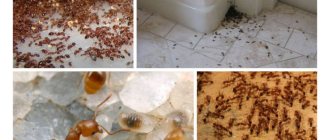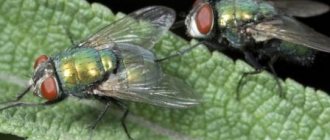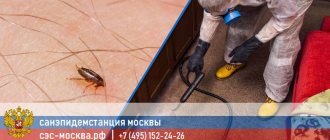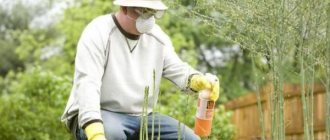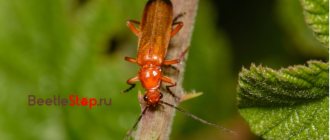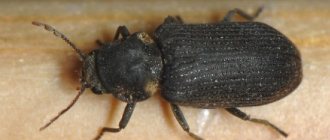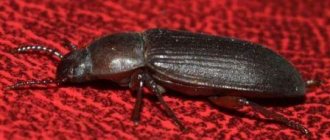Longhorned beetles are the fifth largest family of Coleoptera by number of species. They are easily distinguished by their long antennae, which are 2-4 times their body size. The family includes 26 thousand species, of which 583 live in Russia. The distribution of beetles is associated with forests; they are found in places rich in wood. Most of the representatives of the group are of medium size. One of the common types of leptura is four-banded. The beetle has four yellow bands on its elytra. Adults feed on nectar, while larvae require deciduous wood.
Gravedigger beetle
Gravedigger beetles (lat. Nicrophorus) are one of the best orderlies in the animal world: they bury the corpses of small animals and contribute to their speedy processing. Someone has to do this! But their actions are not dictated by a love of purity or humanity. It’s just that these bugs, belonging to the family of carnivores, turn the carcasses of dead animals into a food source for their offspring.
It is amazing how much burying beetles worry about the future of their larvae, which, in general, is not typical for insects that do not live in communities, like ants or bees. About 68 species of gravediggers are known, living almost everywhere except Australia and tropical Africa.
These rather large bugs with a body length of 1 to 4 cm wear the black “clothes” of funeral service workers, only slightly embellished with small orange or yellow spots located on the truncated elytra. They have a large head with antennae, each tipped with an orange or black club. With the help of this sensitive organ, burying beetles are able to detect carrion located hundreds of meters away from them.
The “funeral” is usually carried out by a male and a female, who have driven away all competitors, but sometimes the work is done with one female and several males, counting on their share. A hole is dug under the dead animal, into which it falls under the influence of its own weight.
Moreover, if the soil here is hard and poorly cultivated, the beetles move the corpse to a looser surface, undermining the soil beneath it and gnawing the stems of interfering plants. Quite quickly (within one to two hours, so that carrion flies or other carrion eaters do not arrive), the carcass ends up in a hole and is covered with earth.
All subsequent work is done by the female, who, after mating with one male, drives him away. She begins to dig again, this time creating a niche in the ground for her offspring. This niche will protect the eggs and provide the larvae with quick access to food.
Having laid several dozen eggs here, the female again returns to the buried corpse and prepares a “nutritious” dish from it. She gnaws it in several places, abundantly moistening them with her digestive juice, which turns the animal's hard tissues into liquid. When the larvae hatch, they will be able to feast on this peculiar broth.
In addition, the mother also takes care of the purity of the “product”. She treats the fur and skin of the buried animal with a special antibacterial secretion from special anal glands. The enzyme destroys aggressive microflora and keeps the carcass relatively “fresh”.
But caring for the offspring does not end there either. Leaving the eggs for a while, the mother returns to the laying site by the time the newborns appear. She clears a passage for them to the stored supplies and makes sure that there are not too many larvae, killing the weak and non-viable.
The larvae have 6 eyes on each side and 6 underdeveloped legs. They grow very quickly and after 10-12 days they burrow into the ground to pupate. After 2 weeks, young bugs appear.
Wasp-like insect
Although carpenter bees are non-aggressive in nature, they are often called black hornets or black wasps. The reason for this is their large size (up to 3 cm), as well as the strong noise that insects make when building a nest. Sounds comparable in strength to the sound of a drill can be heard for several meters. The carpenter bee received comparison with the wasp for the painful and even life-threatening effect of the poison, the consequence of which invariably is severe swelling.
Representatives of a rare species can be distinguished by their characteristic features:
- Large body black with a bluish tint on the abdomen;
- Long black hairs cover the entire body;
- The wide head is almost equal to the width of the chest;
- Large wings with dark purple veins and jagged edges;
- The male differs from the female in its smaller size, as well as the presence of a reddish tint in the lower segment of the antennae. In addition, the male does not have a stinger.
Important! There are no pollen baskets on the hind legs - they are completely replaced by long, thick villi.
Gravedigger beetles (lat. Nicrophorus)
Oh, and they were named! Although... there is nothing terrible about it, quite the contrary. These beetles from the family of carnivores are of great benefit. They are the best and most conscientious orderlies of the animal world. Gravediggers, in the literal sense of the word, bury the corpses of small animals. But they do this not for others, but first of all, for themselves. These corpses will serve as an excellent food base for their larvae in the future.
Gravedigger beetles (lat. Nicrophorus) (eng. Sexton Beetle)
Burying beetles have also become famous for their intelligence (if this concept is generally applicable to insects) and incredible care for their offspring. But before revealing all their secrets, let’s take a closer look at the physiology and habitat of this unique creature.
There are 68 species of gravediggers in the world. They are distributed almost everywhere, with the exception of tropical Africa and Australia. 20 of them live here in Russia.
Outwardly, they are very cute creatures. These are large black beetles with orange or yellow spots on the elytra. Their body length, depending on the species, can range from 1 to 4 centimeters. The large head is “decorated” with antennae with clubs at the ends. It is thanks to them that beetles, even with weak breaths of air, are able to “smell” the smell of decaying flesh, even if it is several hundred meters away.
Having reached the corpse, the gravediggers, like real foremen, begin to assess the scope of the upcoming work. This is done in order to bury the dead body as quickly as possible, before other scavengers, such as carrion flies or other carrion eaters, get to it first. The beetle climbs under the body of its “prey” and begins to dig the ground underneath it until it settles deeper under its own weight.
If the corpse lies on too hard ground, then the beetle with its whole body tries to move it to the side with softer soil. If plant stems get in his way, he gnaws them at the very base. It is practically impossible for one beetle to do this, so several insects work on one animal corpse. After some time, an earthen ridge forms around the dead animal, and the body itself settles under its own weight and is then covered with earth.
Photo by Eigenes Werk
But...several insects took part in the work, most often several males and a female, and as a result, only two remain near the “grave” - a male and a female, who, after mating, tries to drive away the male. But this is done not because of greed or the desire for sole ownership of a large sum, but purely because of “maternal” instincts. By the way, adult beetles practically do not eat carrion; all good things are intended exclusively for their offspring.
Then the female alone begins to dig a small underground niche, which opens to the carcass of the buried animal. Having laid a couple of dozen eggs there, the female returns to the corpse and begins to gnaw several funnel holes in it, into which she regurgitates her digestive juice. What are all these tricks for? All for the same thing, for his beloved and beloved offspring.
Fighting methods
Methods for getting rid of skin beetles depend on the number of animals and their location.
Order in the room
You can get rid of carpet beetles if you use a vacuum cleaner twice a day for 10 days in places where they are expected to accumulate, under baseboards, in corners, in closets. The vacuum cleaner bag should be shaken out thoroughly after use. It's even better to use a disposable paper bag.
Effects of temperature
- Things infected with larvae should be thoroughly frozen in winter, and fried in the sun in summer.
- Treat all hard-to-reach places with a steam generator for several days in a row.
Special preparations
The simplest and most inexpensive method of getting rid of skin beetles is boric acid. To destroy, you need to scatter boric acid powder under baseboards and carpets.
Using chemicals against moths is the easiest and most effective way. These can be insecticides, aerosols and fumigators.
Traditional methods
These methods can be used as prevention or for minor damage. Sometimes they are used in combination.
Vinegar
Surfaces are wiped with the solution to repel beetles.
Herbs
Fresh ones can be laid out. Chrysanthemum, tansy, chamomile are suitable.
How to distinguish good ladybugs from bad ones
Did you know that not all ladybugs are created equal? We are used to discussing this insect exclusively in a positive way. Everyone knows that they are helpers in the garden, kill harmful insects and control the population of aphids and spider mites. But not all species are our friends in the garden, let's take a closer look.
We see a hard red shell with black spots and automatically assume it is a friendly ladybug. But those little bugs in your garden may actually be a species that gets into your home, bites, gives off a foul odor, and eats your plants. Their name is Asian ladybug or Harlequin ladybug
. How to distinguish it?
Damage to agricultural land
The larva is the most voracious growth stage of the striped click beetle. All she does is eat, grow, shed, eat and grow again. And so more than four years pass. During this time, it manages to cause great damage to the harvest of root crops and cereals. Potatoes, beets, carrots, wheat, rye, oats, barley, you can list the favorite dishes of this glutton for a long time. Larva
just an omnivorous pest that you have to fight. Otherwise, gardeners will not see a harvest.
Lyarva (that's how "larva" sounds in Latin) - the post-embryonic phase of the beetle's life cycle - prefers moist peat soils; there are so many of them here that up to 300 are found per square meter. Although 25 larvae per square are enough for complete loss of the crop. They are less common on sandy and soddy-podzolic soils.
Hard wireworms travel in the soil in all directions and gnaw tunnels in potato tubers, beets, devour seeds with seedlings, roots of young fir trees, and nodes of bushes in forest plantings. A plant damaged by larva dies or grows underdeveloped. The great harm caused to agriculture forces people to fight these harmful insects.
Identifying Beneficial Ladybugs
Regular ladybugs are useful for the garden and harmless to humans. They don't bite and kill garden pests such as aphids and scale insects. When fall arrives, ladybugs seek shelter outside, and they do not congregate in huge numbers.
You can identify a beneficial ladybug by its pattern and size. They have bright, cherry-red shells with black spots, and black heads with small white “cheeks.” Ladybugs are generally rounder and smaller than Asian beetles when viewed side by side.
Characteristics
The bumblebee is a large insect whose diet includes pollen and nectar. Their competitive advantage over bees lies in their warm-blooded body. This feature was formed due to the fact that the pectoral muscle contracts at a rapid pace, dispersing blood. Therefore, the bumblebee is not afraid of frost, that is, it leads a cold-resistant lifestyle.
Scientific classification:
- domain – eukaryotes;
- kingdom - animals;
- phylum – arthropods;
- class - insects;
- order - Hymenoptera;
- family - real bees;
- genus – bumblebees (Bombus).
At first glance, a bumblebee looks like a bee, but the adults still do not resemble each other in everything. The main difference is the thickness of the cover. The body of a bee is covered with sparse hairs, while bumblebees have a shaggy coat.
Characteristics:
- dense, thick body - wider than that of a bee or wasp;
- a smooth sting without serrations in females and working specimens;
- body length (size) – up to 3 cm;
- weight – worker up to 600 mg, uterus up to 1 g;
- color – black and yellow stripes, sometimes there are orange-red rings or completely black color;
- length of the proboscis is 7–20 mm (the task is to penetrate the flower for nectar).
Bumblebees are frost-resistant insects. The appearance of this feature is explained by the rapid contraction of muscles and the presence of thick integument. The hairs warm the body, so adults are not afraid to fly out in cold weather, early in the morning and late in the evening. To cool down in the heat, the bumblebee secretes a drop of saliva - this method helps facilitate flight due to the evaporation of liquid and cooling.
What is different about the Asian ladybug?
To tell the difference between an Asian beetle and a ladybug, look at where the head meets the wings. If the beetle has a small white "m" in that location, that's a sign that you're dealing with an invasive species
. They also have larger white "cheeks" and have more white on their heads. It is invasive because it is not geographically native to our area, but was brought from Asian countries. Such insects are gradually replacing native species. Their shell color can range from light orange to bright red, so most species will resemble a ladybug.
Features of life
Despite the name “solitary bees,” representatives of the species still have contacts, since the instinct of procreation is one of the main ones in nature.
Each male protects his territory, where 5-6 females live
When a new individual appears, the male rises to a hill (branch or bush) and attracts her attention with a strong buzz.
If the female does not leave the nest, the male can penetrate inside and appear outside up to several times until his chosen one pays attention to him. Although not an active honey plant due to the absence of a queen, the carpenter bee is nevertheless distinguished by great endurance and is able to fly long distances in search of food. Representatives of the species are hard-working and work even in bad weather, making the carpenter bee a valuable pollinator
Representatives of the species are hard-working and work even in bad weather, making the carpenter bee a valuable pollinator
Although not an active honey plant due to the absence of a queen, the carpenter bee is nevertheless distinguished by great endurance and is able to fly long distances in search of food. Representatives of the species are hard-working and work even in bad weather, making the carpenter bee a valuable pollinator.
Important! In the same nest, up to 10 generations of xylocope can change - the dwelling will remain inhabited until the wood deteriorates. Although insects prefer secluded habitats (forest edges, steppes, forest-steppes), often the lack of suitable material pushes them to colonize human homes. In this case, there may be a threat to life, since a sting in the throat of such a bee is fatal
In this case, there may be a threat to life, since a sting in the throat of such a bee is fatal.
Carpenter bee: how to get rid of it
To detect unpleasant neighbors, it is enough to know a few facts about them:
- The carpenter bee prefers weathered wood from softwood trees;
- A painted or treated surface will not attract insects - they need natural raw materials to build a nest;
- The greatest activity is observed in the spring - it is during this period that young individuals look for a place to live.
If you detect carpenter bee passages, use one of the following:
- Insecticides, gasoline or just water;
- Sealants, glue, steel filings for puttying passages;
- Essential oils of citrus and almond.
When carrying out work, do not forget about personal protective equipment, and if there are a lot of nests, then resort to the services of professionals.
Although violet xylocopa poses a danger if contact is too close, its positive qualities (hard work, unpretentiousness, non-aggression) attract beekeepers who continue to try to domesticate the carpenter bee. However, to date, all of them remain unsuccessful - representatives of the species prefer natural conditions of the wild.
How to control
The best way to keep Asian beetles out of your home is to seal and patch all cracks and potential entry points. If they get into your home, try not to squash them as they will release their smelly yellow liquid. The best way to avoid odors and stains is to vacuum them up. Keep them in a sealed bag before throwing them in the trash so they can't crawl out.
Outdoors, you can clean areas where bugs tend to congregate with soapy water—they likely won't come back because the smell of soap overcomes the pheromones that attract bugs to the area. They especially don't like the smell of citrus fruits, cloves or bay leaves.
You can also take steps to attract native ladybugs to your garden. They will crowd out Asian ladybugs. Avoid using chemicals in your garden and grow pollen-rich flowers. Beneficial ladybugs are attracted to light and bright colors, so look for white and yellow varieties of flowers.
Prevention of skin beetles
After getting rid of these pests, it is worth taking all possible measures to ensure that the insects do not return. Therefore, you must follow these steps:
- It is advisable to store leather and fur clothes in the off-season in vacuum bags or together with moth tablets or mothballs; cedar shavings are also good at repelling skin beetles;
- all cracks in the window sills and frames should be sealed, a mosquito net should be attached to the windows, and a fine grille should be attached to the ventilation holes;
- you need to regularly clean carpets and rugs to minimize the possibility of skin beetles appearing there;
- It is advisable to check cereals, crackers and flour purchased by weight for the presence of bugs and larvae, and store uninfected products in tightly closed containers;
- It is worth doing wet cleaning more often; the best option for preventing the appearance of skin beetles would be to clean all surfaces using a steam generator;
- dried lavender or wormwood inflorescences should be placed in bedside tables and cabinets;
- It is advisable to get rid of things that no one uses as often as possible.
Although skin beetle larvae can cause serious damage to property, if these “neighbors” are detected in a timely manner, you have every chance of getting rid of them. But it’s still better to avoid their occurrence altogether by using preventive measures.
Species of black tree bumblebees
It is easy to confuse different types of tree bees. For example, the common xylocopa will be larger than the purple one. There is also a difference in the color of the wings.
Violacea, Valga, Iris
Blue color is the attribute of the purple carpenter. In total, the genus Xylocopa includes 500 species.
Habitat
All "carpenters" live in dry or rotten wood. Typically, bees choose trees in groves and deciduous forests. Both poles and wooden buildings are used. Habitat of Xylocopa Violacea:
- Countries of Southern Europe, the Caucasus, Turkey, Ukraine, South-West Asia, the Middle East;
- In Russia: the Republic of Crimea, the regions of Voronezh, Belgorod, Kursk and Ryazan, Samara, Penza, also Astrakhan and Vladimir, Krasnodar Territory and Stavropol Territory. The species is distributed in Chechnya, Dagestan, Adygea, Ingushetia and Kabardino-Balkaria; it is found in Tatarstan, Bashkortostan, Mordovia, in the Rostov and Tambov regions.
The bairach forest consists of broad-leaved trees on the slope of a ravine or ravine.
The purple bee, belonging to the genus of carpenters, settles in soft wood, ignoring beech, oak and ash.
Dry wood, Violacea species
Protection measures:
- Use of coniferous wood (not 100% protection);
- Treatment with two layers of varnish: the first layer is used as impregnation, etc. The coloring is not suitable.
An atypical case was observed in Austria in 2004. Bees have gnawed holes in polystyrene slabs.
In any case, the passages turn out to be shallow, especially when it comes to buildings. A rare but possible habitat is the bark layer of a coniferous tree if the bark thickness exceeds 3 cm.
Security
The bee species Xylocopa Violacea was included in the Red Book of the Caucasus regions, as well as the Krasnodar Territory and Stavropol Territory. In Crimea, Volgograd and Samara regions, this species is also protected.
Xylocopa Violacea
Interestingly:
- Xylocopa Valga, that is, “common carpenter” is protected throughout Russia and Ukraine;
- In Belarus, the species Xylocopa Violacea is not protected, but it is found there (Gomel), and this species is included in the Red Book of Ukraine.
The list of protected fauna in each region is supplemented. So the list given here is not complete.
The hornet that resembles tree bees is called Vespa Dybovskii. It was included in the Red Book of the Chita Region. The usual name is the Black Hornet, a pest of all apiaries.
Three types of bumblebees
Well, bumblebees, and not only arboreal ones, do not harm apiary bees. In most regions, the species Bombus Lapidarius, Hypnorum and Terrestris are protected. Translation: stone, hollow, earthen.
